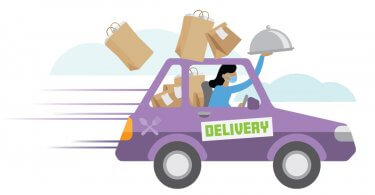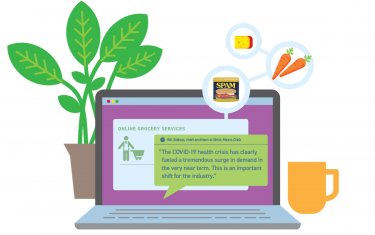It’s been nearly a year since the arrival of COVID-19 turned our lives upside down. No part of society has been untouched or unchallenged. Educators had to develop distance learning programs practically overnight. Offices were shut down, and remote work has become the norm for many. Healthcare delivery systems have had to be overhauled and new vaccine research bootstrapped. Hundreds of thousands of businesses have had to throw out their old business models to stay afloat.
“We are seeing how necessity can inspire innovation,” says Lindsey Lyman, assistant professor of entrepreneurship at University of Chicago Booth School of Business. “Companies, governments, entrepreneurs and citizens have proved how capable humans are of innovating during times of crisis.”
No industry, with the exception of healthcare, has been as upended as the food business during this time. The just-in-time supply chains have been massively disrupted, leaving farmers and ranchers nowhere to send animals and crops. Restaurants have had to try to stay in business without seating customers indoors for months in a row. Retailers have had to explore new ways of getting their products to customers.
“As the pandemic spreads, the interaction between people and the food system is changing at an unimaginable speed and taking on greater importance in everyday life,” says a statement from the United Nations System Standing Committee on Nutrition. “Physical distancing measures are implemented, marketplaces are shut down, limits are imposed on the number of shoppers, long queues are encountered at points of food purchase and empty shelves serve as a sign of the coping mechanism many are adopting.”
The pandemic has changed our fundamental relationship with food. It’s influenced how we shop, where we shop and what we buy. Even as the world is still in the grips of COVID-19 and its long-term economic consequences, it is clear the impact of the pandemic will forever change the food industry. In many meaningful ways, there will be no going back to normal.
Remember, even before COVID-19, our food system was experiencing rapid change. On the farm and in processing facilities, advanced robotics were replacing increasingly scarce labor resources. Big data and artificial intelligence were beginning to make our complex supply chain more efficient, less wasteful and more flexible. Retailers were trying out cashierless systems and curbside pickup, and investing in micro-fulfillment centers for online buying. The gig economy was creating platforms for legions of personal shoppers and home delivery drivers. Consumers were experimenting with buying groceries online, on their phones or by talking to their smart speakers.
All those changes were happening before 2020. What is different now is that the arrival of COVID-19 has accelerated these trends. New behaviors and technologies have been pushed past critical tipping points and are here to stay.
Bamboo Asia, located in downtown San Francisco, tried to pivot to takeout but with few people coming to the financial district to work, the strategy wasn’t working. Now it is creating sous vide meal kits. “These kits are essentially family meals where everything is all ready to be cooked by you,” says Bamboo Asia owner Sebastiaan van de Rijt.
Even though the restaurant industry has been one of the hardest hit during the crisis, it hasn’t stopped owners and operators from finding ways to support their communities. Some have offered buy-one, give-one deals, where the restaurant donates a meal for every one ordered by a paying customer. Even though these experimental new revenue streams were created out of necessity, many look as though they may last much longer than the current crisis.
The creativity of restaurant owners showed no sign of slowing down even as establishments began to reopen. Mama Kat’s, located in a suburb of San Diego, has turned its parking lot into a picnic area where patrons can bring their own blankets and beverages.
Looking to the future, there is little doubt that the foodservice business has fundamentally changed. The total number of restaurants has declined dramatically. Those who survive the crisis will likely be those who do more with less. With smaller kitchens and fewer employees, operators will be looking to order fewer products that can be used in more dishes.
These sudden changes in consumer behavior meant that grocery outlets had to adapt and adapt quickly. Retailers who had made large investments over the last few years in online ordering, home delivery and in-house apps had a head start. Some grocery chains turned the back of their stores into micro-fulfillment centers to assemble online orders. Other retailers, including Whole Foods, Kroger, Stop & Shop and HyVee, closed some stores to the public entirely in order to focus on fulfilling delivery and pickup orders.
The fast ramping up of online shopping hasn’t been without stumbles. Grocery-buying and delivery services saw their social media engagement spike more than 28,000 percent from March 2020 to the beginning of May 2020. Unfortunately, many of the messages people were sharing weren’t positive, calling out delays, shortages, wrong orders and difficulties getting delivery times. Many American shoppers, used to getting exactly what they want, were disappointed.
Even with the difficulties, there is wide agreement among industry experts that the COVID-19 pandemic will be seen as a critical turning point for e-commerce grocery buying. Based on public surveys, analysts predict that online ordering will likely retain most of the gains it made during the pandemic.
“The COVID-19 health crisis has clearly fueled a tremendous surge in demand in the very near term,” says Bill Bishop, chief architect at Brick Meets Click, referring to the rise of online grocery services. “This is an important shift for the industry.”
This will mean a flood of new investment, both by major retailers and venture capital funds, into mechanization, ordering apps and home-delivery operations. Large-scale mechanized fulfillment centers to be built near urban centers will also be fast-tracked.
It’s been 19 years since the dramatic flameout of the dot-com-era online grocery that went bankrupt in 2001 after raising — and subsequently losing — $800 million in its five-year existence. Online ordering and home delivery seem finally ready for prime time.
The Long-Term Effects
In the news coverage of the pandemic, Americans watched as farmers were forced to dump milk and plow under crops that were ready to harvest. This gave us all a new appreciation for how vulnerable our food system can be in times of crisis. This will certainly renew interest in technological advances that can make the supply chain stronger and more flexible. Artificial intelligence, big data, blockchain and mechanized precision farming were all beginning to transform the food industry before the crisis. The full potential value of these new tools has become clear: They will reduce food waste, decrease labor, ensure food safety and help each partner in our food system see the future a little
more clearly.


